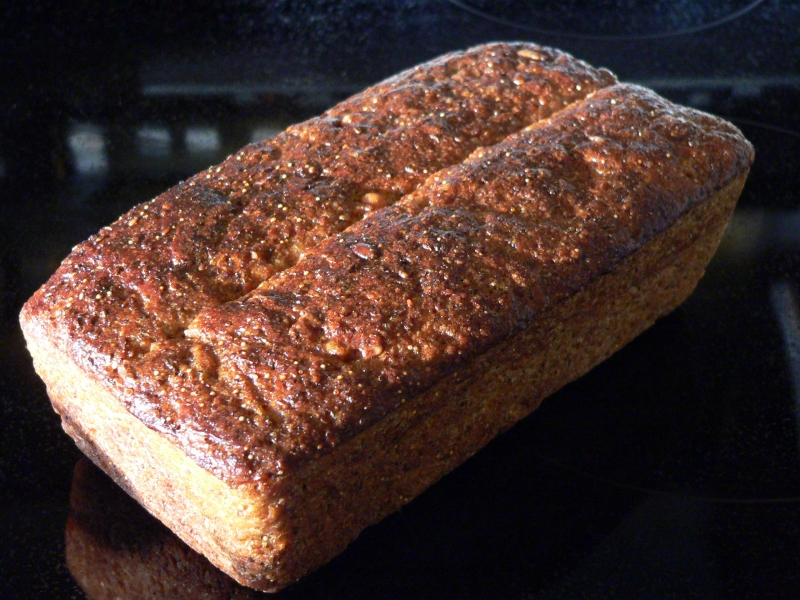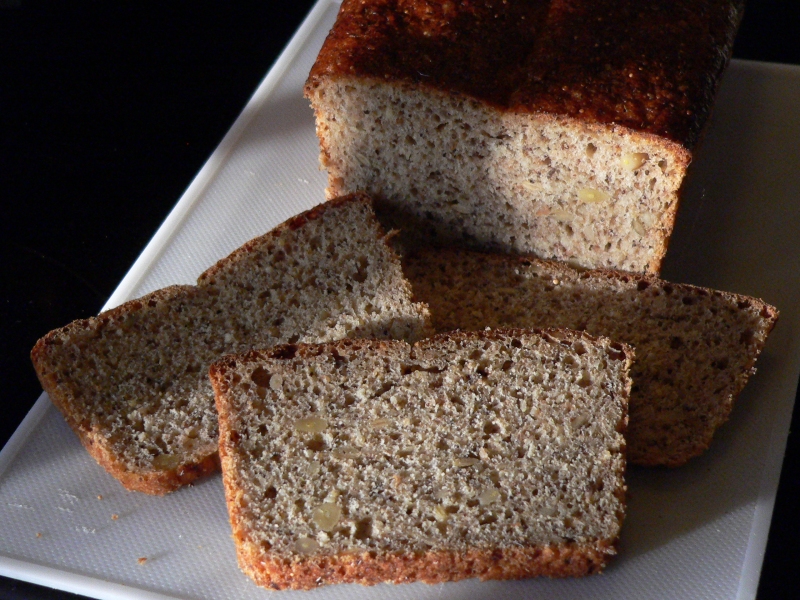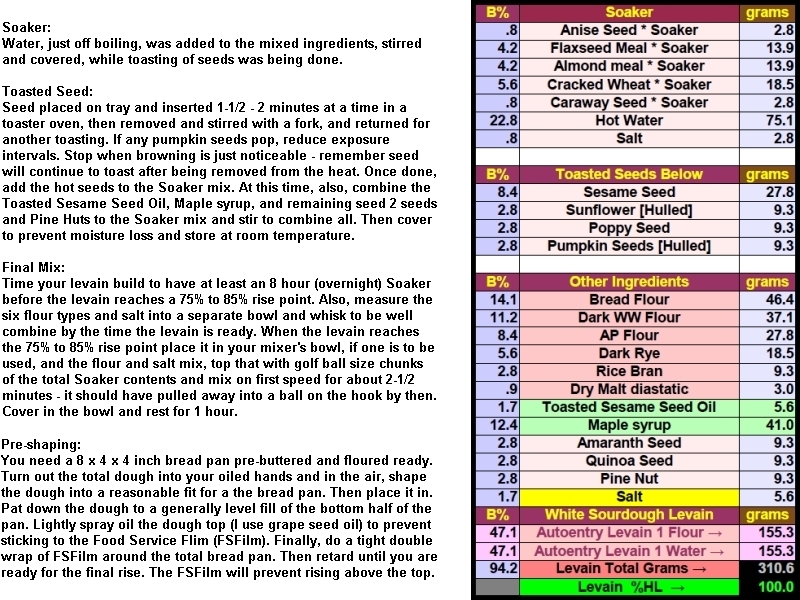No-Knead Multigrain Seed and Nut Loaf
A previous blog:
http://www.thefreshloaf.com/node/20460/banana-saga-%E9%95%B7%E7%AF%87%E6%95%85%E4%BA%8B
Last December a posting by Jaydot caught my interest http://www.thefreshloaf.com/node/21186/huge-amount-seeds-and-sugar
Her sister in law had brought a recipe back from South Africa, which seem a bit strange.
Mini Oven suggested it might be South African Seed Bread, while PmcCool suggested it could be a variation on the Cape Seed Loaf.
After I spent some time seeing what Google had to offer on these subjects I concluded the two things they all had in common was a lot of seeds and no sourdough in sight. It seemed like a fun formula to play with, so I set out trying to come up with a reasonable sourdough version of a seed loaf.
By the end of February, I had a reasonably satisfactory loaf - on my fifth try. When I compared notes with Jaydot, I found that she had independently gotten a loaf that her sister in law found acceptable as well.
I picked up her use of caraway seed and maple syrup as something I wanted to try. So, I dropped the Chia seed and brown sugar I had used, and added her idea of maple syrup and caraway seed. Both proved their worth in the eating of my version number 6.
Number Six had nine (9) types of seed, two (2) types of nuts; six (6) types of flour plus maple syrup and toasted sesame seed oil. I was afraid to calculate the calorie count, but I am certain a person could gain weight on a diet of this bread and water, alone.

The loaf was 718 grams going into the oven and 665 grams at the time it came out of the oven. The instant internal temperature reading was 209ºF (98ºC).
The crumb was as nice, if not better, than the previous version 5 and both v-5 and v-6 were by far the best of the six loaves tested thus far. Texture wise, I feel the better crumb is due to the minimal kneading. The first 4 test loaves were all kneaded gently, but in a rather normal letter fold method common to most of my loaves. I felt that the extremely high nut and seed content did more damage to the gluten during kneading than could be offset by any benefits gained. So, in both v-5 and v-6, I basically switched to a no-knead method, and it seems to have made a major improvement in the openness of the crumb.

All six versions had excellent keeping properties, when kept at room temperature in a simple a bread box.
The sourdough was a 3 build levain using KAF AP flour, and was a baker's 94.2%.

The final rise for this loaf was 7 hours in a proof box at 82ºF( 27.8ºC). By that point it was pressing tightly against the FSFilm. I removed the FSFilm, scored top with 1 whole length center scoring. Bread pan place in a Turkey Pan. The bread pan was elevated from direct bottom contact by two SS knives.
The oven stones were removed from the cold oven. One cup of water was brought to a boil and the boiling water then poured into bottom of the turkey pan and the lid placed on at once, and the turkey pan and its contents were all placed in the cold oven on the lowest rack position. The oven was set to 450ºF (232º C).
With this fabricated "Dutch Oven" - formed from the turkey pan - resting at the lowest position, the constant heat of the electric oven's lower element, while raising the oven's internal heat to its highest setting, maintains the bottom of the "Dutch Oven" well above boiling temperature for 15 to 18 minutes. Steam visibly issues from the oven vent from about 3 minutes into the baking until about 18 minutes.
At 20 minutes, the Dutch Oven's lid was removed, oven heat set to 400ºF (204º C) for the balance of the baking, and the oven door held open by about 1/2" (12 mm) to vent any steam during the remaining 25 minutes of the baking. At the end of the total 45 minute baking, the oven was turned off and the loaf removed from both oven and bread pan. The loaf was placed on wire to cool for two hours. Then it was placed in a bread box at room temperature overnight, before being cut.
At this point, I have no ideas on what I may do different when I bake version 7. In fact, I might just repeat making this same formula, before trying any other possible improvements. Perhaps, that will change
but, for the moment, I am satisfied. ;-)
=====Update: March 18, 2011
Version 7 Seed Loaf has a few changes and , to my taste, is even better. A PDF with full details and photos can be seen at this link:
=====
110307 Next blog:
http://www.thefreshloaf.com/node/22562/sourdough-crackers
- RonRay's Blog
- Log in or register to post comments
Love the big photos! What a gorgeous loaf!
I'm thinking about trying your formula, but it does seem a bit daunting :). The ingredients I buy here would not all be exactly the same, and I don't have the means to control temperatures as precisely as you do. (And I am quite happy with my own version of a multiseed sourdough).
What with the sourdough, whole wheat, and long fermentation, I wouldn't worry about gaining weight unless you plan to eat a loaf a day :).
Thank you, Jay. but I imagine your version is every bit as good - or better. It really is a shame we cannot e-mail samples to taste LOL.
Actually, the most daunting aspect is probably the weighting of all those different ingredients.
BTW, the Quinoa seeds can be clearly seen in the photo. They are the very light colored, tiny seeds seen speckling the top of the loaf.
Ron
Great post, Ron. This is just the sort of bread I have been researching lately. I am going to study your method and formula again. I will definitely be trying this in the not too distant future.
Thanks,
Syd
If you have questions, I'll be pleased to try to answer them. Be sure to let me know how your loaf turns out, too :)
Ron
It is looking a very nice loaf, Ron!! As Jaydot wrote, I am the same situation. I couldn't find some seeds that is in the ingredients. And, I may omit the caraway seed because I am not a big fan of it since I ate a slice of rye bread that contained caraway seed that was over powering to me. But the caraway in your formula is not much... I better try it.
Great write up, Ron!!!
Akiko
Akiko, the seeds that carry the greatest flavor in the loaf are the Anise, Caraway, and Pumpkin. The Pine nuts come next. I guess one might say the others form an accompanying function - as in an orchestra - you want them there, but the are not playing the lead parts. The Amaranth, and Quinoa seed could be left out and little change would be noticed. Also, the Almond meal is more of an aid to the texture than it is to the flavor itself.
I hope that helps you some in your concerns.
Ron
Beautiful, Ron! Its one of those "Whatever you have in your Pantry" Breads..! and you seemed to have done an effortless well done job baking them. Should be very satisfying...
Thank you, Mebake, that does seem a fair way to describe it, and everyone should have at least one such formula when doing house cleaning - LOL
Ron
I tried several times to make a (rye) sourdough with 13 different kinds of seeds, but I could never quite figure out how to bake it right, so I put it on ice.
Karin
Karin, it took 7 versions for me to say it, but I am quite please with version 7. The crushed Black Walnuts just set off the taste, at least for me. From here on, I think the changes will be modest.... like adding a bit of Buckwheat LOL
Ron
I hope those are not what I sometimes achieve: char blackened walnuts.
Where do you get those, Ron? I've never heard of them.
Karin
Karin,
Black walnuts grow on a type of walnut tree that once were often found on the side of the driveways. The fruit is encased in a coarse sheathing of rough leaf green, having the form and size of a tennis ball. The sheathing is not much thicker than twice that of an egg shell, and beneath that skin is a very black pithy pulp that will stain things a purplish black color that is very resistant to removal. The center holds a very hard and thick shelled nut, of a size only slightly larger than a ping pong ball. The shell is sometimes sliced into 1/4 inch thick sections to serve as links in decorative belts, and sometimes craved into a ring. The meat of the nut is - as you can imagine - very hard to pick. The outer husks were often left in driveways until cars driving over them had removed the husk. Few, if any of the nuts cracked. One cracked the nut with a hammer on concrete, rocks, or anvil.
At this point, I imagine you can guess that I do not pick the black walnut to get the nut meat... LOL I love the strong flavor, but if it were not for the fact that I found the local Amish Market stocks the picked meat year round, it would be a rare find.
I just searched, and Wikipedia has some info, under Juglans nigra - http://en.wikipedia.org/wiki/Juglans_nigra
Ron
p.s. I find that Nuts Online stock black walnut meats
http://www.nutsonline.com/nuts/walnuts/black.html?gclid=CKnXjZmd26cCFYxd5Qodpi739w
p.p.s.
http://www.sfp.forprod.vt.edu/factsheets/walnut.pdf
This PDF has much info that I never dreamed of... The black walnut shells are used to clean "Jet engines", etc.
one can never learn enough! Thanks for the interesting information, Ron,
Karin
Anytime, Karin. It is my pleasure.
Ron